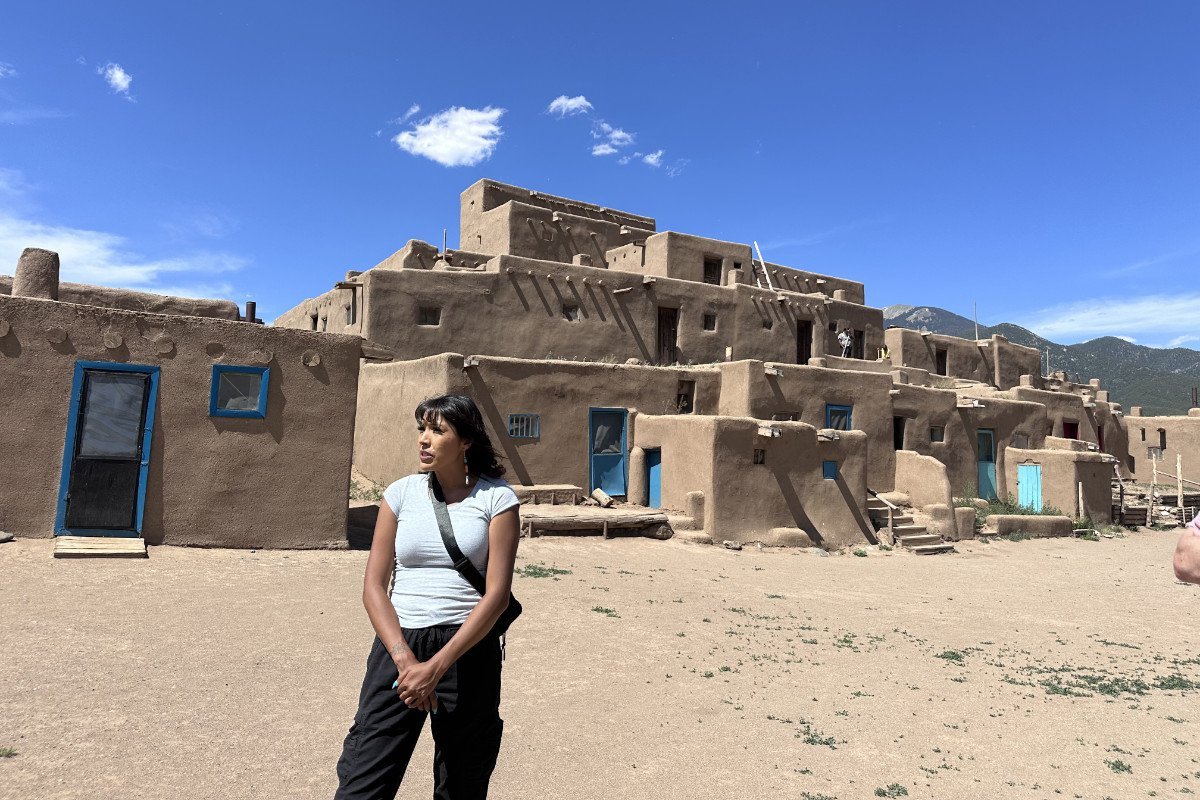TAOS, New Mexico — Let’s start with the name. “Taos” doesn’t quite roll off the tongue, and that’s probably because you don’t speak Tiwa. Meaning “place of the red willows” in the language spoken by the Pueblo people, Taos, New Mexico, has been the home to this matrilineal community for more than a thousand years. For the last century, many artists in search of creative inspiration have found it among the Sangre de Cristo mountains and Red Willow Creek.
In the early 1900s, a group of white women arrived here and quickly became world-renowned, among them painter Georgia O’Keeffe and jewelry designer Millicent Rogers, whose work helped define the “Southwest style” — gauzy mesa sunsets and austere rams’ skulls, chunky silver jewelry with turquoise inlays. But those desert scenes and intricate handicrafts long predated O’Keefe, Rogers, and their circle, having been created by centuries of Indigenous artists whose names we may never know.
But today’s women of Taos — whether they identify as Pueblo, Indigenous, Mexican, Hispanic, New Mexican, or something else entirely — are creating a fresh take on what this storied place can be.
Living History: Taos Pueblo
One of the most iconic elements of Taos is its ancient Pueblo architecture. The adobe design of multi-story dwellings made of sun-dried clay, sand, and straw is incredibly durable and beautiful. It caught on. Nearly every building here is in the adobe style: family homes, hotels, shopping centers, even the local McDonald’s.
It all started in what’s now known as the village of Taos Pueblo, a UNESCO World Heritage site and a living community.
This is where I met Bear, a millennial who lives here but straddles two worlds. She has silky black hair with short bangs that frame her round face. She wears false eyelashes that accentuate her almond-shaped eyes rimmed with black liner. Her acrylic nails are long and lacquered, painted bright turquoise-blue. They look to me like millennial-chic bear claws.
We stood next to the pristine, protected Red Willow Creek and chatted about elders, colonialism, respect for nature, #NativeTikTok (she’s not a fan), and the need for everyone to be a little more human.
“We are a sovereign nation, not a reservation,” she explains. “Our homes are passed down on the mother’s side. My grandmother, who is also called Bear, gave me mine.” She may live part-time in an adobe home, but the younger Bear is fully part of mainstream American society. An alumna of the University of New Mexico with a degree in psychology, she has lived in San Francisco and traveled internationally. Oh, and she’s a rapper.
Earlier this year, B3ar MC (her name in hip hop circles) performed at Revolt Gallery to raise funds for the Taos Alliance for a Free Palestine. She sees her people and her history, in today’s Gazans. In an Instagram video of the performance, B3ar stands in front of a hand-written sign that reads “Netanyahu is a criminal.” She wears sunglasses, a Palestinian keffiyeh, and spits to the crowd:
I’m a proud Indigenous women
Yes, I’m blessed
Represent what I’ve been
I am who I am
Even if you can’t stand this
Livin’ my best
So I live a long life span
For the younger generations



The Place to Stay for Remarkable Women of Taos
During my time in Taos, I posted up at the independent Palacio de Marquesa, a quiet and quintessentially Southwest property built in the adobe style. Naturally. Part of Heritage Hotels & Resorts, every room “pays homage to a remarkable woman of Taos.”
Interior designer Adriana Long created the concept. “All of these women worked together in developing Taos to make it what it is today,” Long told me. Each sleeping room is dedicated to a specific woman’s style. I slept in Socialite Suite I, a turquoise-and-silver homage to the Standard Oil heiress and designer Millicent Rogers.
After fleeing to Taos after her breakup with Hollywood star Clark Gable in 1947, Rogers quickly came to admire — and then, I’d argue, appropriated — Pueblo jewelry design. This inspired many of her own creative silver and turquoise pieces, which landed her on the pages of Vogue and Harper’s Bazaar. (Needless to say, no Pueblo women were receiving full-page fashion spreads for their original creative work.)
“Millicent Rogers was all about her turquoise jewelry and her fashion,” Long says, “so that room has the subtle difference of the turquoise lamps and the dresser that is a little more glam than the mid-century in the [painter] Agnes Martin room. She was more minimalist and used very little color, so her room is more muted.” The Millicent Rogers Museum in Taos takes a strong look at the past, but also elevates contemporary Indigenous artists in the Taos Pueblo Gallery, opened in 2021.

Women and Wine
Winemaking is its own art, and it has been in New Mexico since 1629, making it the country’s oldest wine-growing region. (California planted its first grape in 1769.) What’s also surprising is that it’s the wineries’ women vintners, owners, and marketers who are cultivating a new New Mexican wine scene in this centuries-old, male-dominated industry.
Among them is Katie Hagan, who, at age 34, is the youngest winemaker in New Mexico’s history. Bright-eyed and bold, she doesn’t pull any punches as she charms you. Maybe that’s because she was a child actor (appearing in the 1998 movie Deep Impact with Elijah Wood) or because she’s a native Texan.
After a stint at La Chiripada, Hagen recently became the vintner for Embudo Valley Vineyards, the state’s oldest winery, found on the outskirts of Taos. In their cozy art-filled tasting room, wearing khaki overalls and a red neckerchief, she explains how she landed the job of head winemaker without any training.
“I literally had developed a work ethic at five, maybe even earlier than that. And I live in a state where half the people don’t show up for work.” While that might be an exaggeration, I can say that the vibe in northern New Mexico is…unhurried.
“My job is to listen to the grapes and then try to make the best possible wine.” Her instincts seem to be right, as the 2022 dolcetto that I tried at La Chiripada was excellent, as was the 2023 Amphora malbec. Hagen convinced the owners to invest in an actual amphora, a thousand-pound terracotta vessel that dates back to the Neolithic period, that she used to age the wine in a time-tested tradition: Amphorae allow wine to micro-oxygenate as they would in an oak barrel, without imparting the flavors and tannin from wood.
An old style, but a new approach for Taos.
Maybe that’s what the women I met in northern New Mexico are really trying to do. Preserve the good of the past, the old ways, and the roots, but make room and make right whatever they can for a better, more equitable future.













Leave a Reply